Performance Review Policy Template
Purpose
This policy establishes a standardized framework for conducting employee performance reviews to support professional development, recognize achievements, and align individual contributions with organizational goals.
Scope
This policy applies to all employees, including full-time, part-time, and contract workers who have completed their probationary period.
Review Frequency
Annual Reviews
Conducted once per year for all eligible employees
Scheduled within 30 days of the employee's hire date anniversary
Comprehensive evaluation of performance over the previous 12 months
Mid-Year Reviews
Conducted six months after the annual review
Focused on progress toward goals and course corrections
Less formal but documented
Probationary Reviews
New employees reviewed at 90 days (or as specified in employment agreement)
Determines continuation of employment and transition to regular status
Review Process
Preparation Phase (2-3 weeks before review)
HR notifies managers and employees of upcoming review dates
Employees complete self-assessment forms
Managers gather performance data, feedback from colleagues, and review documentation
Managers complete preliminary evaluation forms
Review Meeting
Manager and employee meet privately for 60-90 minutes
Discussion covers:
Achievement of previous goals and objectives
Job knowledge and skills
Quality and quantity of work
Communication and teamwork
Areas of strength
Areas for improvement
Career development interests
Goals for the coming period
Documentation
Manager completes formal review form within 5 business days
Employee reviews and signs documentation
Employee may attach written comments if desired
HR receives and files completed reviews within 10 business days
Evaluation Criteria
Performance is assessed using a standardized rating scale:
Exceeds Expectations: Consistently surpasses performance standards
Meets Expectations: Consistently fulfills all performance standards
Needs Improvement: Partially meets standards; requires development
Unsatisfactory: Does not meet minimum standards; immediate action required
Evaluations consider:
Goal achievement and results
Core competencies relevant to position
Adherence to company values
Professional development and growth
Goal Setting
SMART goals (Specific, Measurable, Achievable, Relevant, Time-bound) established during each review
Goals aligned with departmental and organizational objectives
Progress reviewed during mid-year check-ins
Performance Improvement Plans
Employees rated "Needs Improvement" or "Unsatisfactory" may be placed on a Performance Improvement Plan (PIP) outlining specific expectations, timelines, and support measures.
Compensation and Promotion Decisions
While performance reviews inform compensation and promotion decisions, they are not automatic guarantees. Merit increases and promotions are subject to budget availability and organizational needs.
Confidentiality
Performance reviews are confidential and shared only with the employee, their direct manager, HR, and senior leadership as appropriate.
Employee Rights
Employees have the right to:
Provide input through self-assessments
Discuss ratings and feedback openly
Attach written responses to their review
Appeal ratings through HR if they believe the review was unfair or biased
Manager Responsibilities
Provide ongoing feedback throughout the year, not just during formal reviews
Document performance issues and achievements as they occur
Conduct reviews in a timely, fair, and objective manner
Ensure reviews are free from bias and discrimination
Review and Updates
This policy will be reviewed annually and updated as needed to reflect best practices and organizational changes.
Policy Effective Date: [Insert Date]
Policy Owner: Human Resources Department
Last Reviewed: [Insert Date]
Next Review Date: [Insert Date]
Performance Review Policy Template
1.PURPOSE
1.1 The objective of this policy is to try and provide a link between the overall vision, strategic priorities and goals of the company with individual goals, performance standards and expectations, and formalize information for reward and recognition programs (based on objective parameters) within the organization. The vision and strategy incorporates financial, internal business processes (services of care), learning and growth and customer objectives, measures, targets, and initiatives.
1.2 To guide all employees through the performance appraisal process in order to manage and contribute to improving overall performance and the achievement of objectives.
1.3 To provide guidelines for the supervisor and employees to discuss and assess the employee’s performance, and to provide guidelines for training / development, follow-up and review.
1.4 To improve the channels of communication between managers, supervisors, and staff contributing to the developing of a better and more productive environment that actively supports continual quality and practice improvement and safety.
1.5 This policy must be read in conjunction with the probationary review policy, and the policies on competency, Training and Development.
2.POLICY
2.1 The performance appraisal scheme applies to all employees of the Organization. The scheme is customized to meet the particular needs of the specific roles and responsibilities of all levels of employee throughout the organization (includes all administrative and clinical staff).
2.2 Achievements are reviewed against goals or objectives, and with regard to the main competencies, for every profile depending on job description titles, and which may include:
2.2.1Strategic skills
2.2.2Operating Skills
2.2.3Courage ;Energy & Drive
2.2.4Teamwork
2.2.5Productivity
2.2.6Responsibility
2.2.7Accountability
2.2.8Personal and Interpersonal Skills including conflict and political negotiation, teaching, coaching, communication and consultation.
2.2.9(The above incorporate the employee’s specific achievements / aspirations incorporating the organization’s Mission, Vision, and core values)
2.3 Completion of all mandatory training and relevant department specific competencies; general orientation processes all signed off, including introductions to quality and risk management, are mandatory.
2.4 An employee will be expected to participate annually in the performance management process; all employees will be asked to self-appraise, in the first instance. The first annual appraisal takes place a year after the employee joins the organization regardless of when the probationary appraisal takes place.(Employee will fit into yearly appraisal planning process: objective setting and review Mid-year, and review at the end of the year.)
2.5 Appraisal does not remove a manager’s responsibility to establish and maintain a dialogue with an employee regarding their performance on a day-to-day basis, but provides a positive opportunity to motivate employees and stand back from day-to-day matters and take stock of all these discussions.
2.6 Appraisal should not be used as a disciplinary mechanism to deal with poor performance, but may provide evidence of action taken that would support the implementation of other means thereby improving performance, and discontinuation of what might be disturbing trends.
2.7 Information gathered during appraisal will be confidential to the parties involved, i.e. the employee, immediate manager of the employee, HR, and executive.
2.8 The performance appraisal for all clinical staff makes use, additionally, of the following as basis for the review:
2.8.1Chart Reviews / Peer reviews
2.8.2Mortality and Morbidity; procedural outcomes
2.8.3Incident Reports
2.8.4Client Satisfaction Survey – as necessary and pertinent
2.8.5Desired work behaviors: teamwork, collegiality, etc.
2.9Board and Directors Appraisal Review
2.9.1The process of evaluating the performance of the Board as a whole is the responsibility of the Board under the direction of the Chairman. The evaluation of Board performance involves:
2.9.1.1At the start of a period, the Board discussing the objectives to be achieved.
2.9.1.2At the end of the relevant period, the Board assessing the extent to which objectives were achieved by the Board.
2.9.1.3Assessment of individual directors' performance is a process determined by the Chairman, and draws on a range of techniques, including: discussion of Board and individual directors concerning their perceptions about the Board and Directors performance; and one-on-one interviews of directors with the Chairman when perceived as necessary.
2.9.1.4The Board assesses the CEO.
2.10The performance evaluation of the Chief Executive Officer is the oversight function of the Board. The evaluation of the Chief Executive Officer involves an assessment of a range of factors including the overall performance of the Company and the achievement of pre-determined goals.
2.11Executives / Management team
2.11.1 All company executives (other than the Chief Executive Officer) are subject to annual performance review by the Chief Executive Officer and if applicable, in conjunction with another senior executive.
2.11.2Executives are assessed according to various criteria, which may include:
2.11.2.1Completion of key job specifications and goals.
2.11.2.2Contribution towards specific business plan objectives.
2.11.2.3Effectiveness of leadership role played in heading up Operational
Committees and Contribution towards Board / Operational
Committees.
2.11.2.4The outcomes of executive performance reviews are reported to the Board, which has overall responsibility for ensuring that adequate performance management processes are in place for all executives.
2.12The Performance Management Procedure can be applied for periods of less than a year (interim appraisal) if Performance Management issues are raised.
3. PROCEDURE
3.1 Department manager/ immediate manager and each individual employee Identifies an action plan: priorities, objectives and targets for a yearly time period on which an employee will be evaluated. Interim goals ( 6 monthly) must be action planned and followed up on time, and documented as having been completed
The timelines:
•May-June, midyear: HR will ’nudge’ everyone into the beginning of the APR ( Annual Performance review)
•Employees are expected to initiate the process by completing self-reviews/comments
•Self-review comments include (e.g.); ‘How have you performed on your KPIs, the challenges and achievements so far’?
•Once manager has reviewed submission, a discussion will be held and targets agreed
•Nov-Dec, Annual review: employee will receive feedback at Mid/End of year, based on the actual achievements as compared to targets agreed during the cycle ( beginning of the year)
•Specific development areas, trainings and next steps will be agreed between managers and subordinates, based on the review discussion
3.2 An Agreement will be in place between the team manager and the individual employee on the annual goals set.
3.3 Self-Appraisal by the employee will be carried out on the basis of identified competencies and goals as per pre-defined targets and goals. Members of staff / superiors and subordinates will be asked how they perceive the employee (constructively scripted).
3.4 The Manager will conduct the performance review for each individual team member within their department. This will be carried out in a formal one-on-one discussion format and includes but is not limited to job description requisites, desired work behaviors, patient satisfaction surveys, what the employee may further require from the company).
3.5 The Employee and Manager agree on the rating (both for objectives, and competencies) of the individual for the last period’s performance, with the action plans/goals and objective setting for the next years’ time period and an achievable development plan ( using the acronym SMART):
•Specific / strategic
•Measurable
•Achievable
•Timeframe
To achieve higher productivity and performance. Both sign to this effect.
Quick Check while doing the Performance Review:
• Objective Setting Sheet- This sheet is used for Goal Setting process along with the employee. It is not necessary to have 5 Objectives, one can also have 4 or 6 depending on the role and complexity.
• Total Sum- Please make sure the total sum of all the Objectives should not exceed 100 i.e. One goal can have a maximum of 25% or minimum of 10% weightage attached to it.
• Examples are available from HR to guide employees and managers
• Objective Evaluation Sheet- Annual Evaluation Achievement means how much does the Manager feel an employee has achieved. For e.g. if any goal had a weightage of 25%, how much the manager feels it is achieved? It can be 15-20-25% depending on manager evaluation.
• Behavioural Competency Review- This can be done completely by the Managers, This must be discussed with and signed off by the employee
3.6 Appeal Procedure: Where an agreement is not reached and friction disrupts the department, the issue should be referred to the Senior Manager within the service area who will, within 5 working days, listen to the concerns of both parties and facilitate an agreement or a way forward which both parties are committed to.
3.6.1Where an agreement is not reached and both parties are committed to working effectively, parties can agree to disagree and sign to that effect.
3.6.2If on review a senior manager feels that 3.6.1 is not appropriate, the manager must initiate discussions with the parties concerned. This process and its outcome must be documented on the said Appraisal form.
3.6.3If disagreement persists the matter will be referred to the head of department who will, within 5 working days, hear the concerns of both parties and resolve the matter.
3.6.4The decision of the head of department will be final and given, in writing, within 5 working days of the meeting.
3.6.5In cases where the head of department is involved with Stage One of the procedure, or unavailable, the matter will be referred to COO/Director-HR, by mutual agreement.
3.7 This performance process supplies data and information to HR KPIs;
CONTRIBUTION FROM THE EMPLOYEE; DISCIPLINE AND DILIGENCE FOR SEEING THE PROCESS COMPLIED WITH informs quality process within HR and contributes to the employee performance appraisal, in line with strategic goals and objectives target plans
4. REFERENCES
4.1 Policy and procedure on Grievance
4.2 Probation performance review policy
4.3 PMS Objective and goal setting, and competency forms
What is a Performance Review Policy and Why Do You Need One?
A Performance Review Policy Template is a structured document that establishes the framework, procedures, and guidelines for conducting employee performance evaluations within an organization. It serves multiple purposes:
- Ensures consistency and fairness across all departments and teams
- Sets clear expectations for both managers and employees
- Provides legal protection by documenting standardized evaluation processes
- Improves employee development through structured feedback mechanisms
- Aligns individual performance with organizational goals
- Creates transparency in promotion and compensation decisions
- Establishes a paper trail for performance-related employment actions
Who Should Create and Approve Performance Review Policies?
- Human Resources Department: Primary authors who draft the policy framework and ensure legal compliance
- Executive Leadership: CEO, COO, or senior management who provide final approval and strategic direction
- Legal Counsel: Reviews policy for compliance with employment laws and regulations
- Department Heads: Provide input on department-specific evaluation criteria and practical implementation
- Employee Representatives: May contribute feedback during policy development to ensure fairness
- Board of Directors: In some organizations, particularly smaller companies, may need to approve major HR policies
When Should Performance Review Policies Be Communicated?
- New Employee Onboarding: During the first week of employment as part of orientation materials
- Annual Policy Updates: At the beginning of each fiscal or calendar year when policies are refreshed
- Prior to Review Cycles: 4-6 weeks before scheduled performance review periods begin
- After Major Policy Changes: Immediately following any significant modifications to the review process
- Promotion or Role Changes: When employees move into supervisory positions requiring them to conduct reviews
- Performance Improvement Plans: When initiating formal performance management processes
- Organizational Restructuring: During mergers, acquisitions, or significant company changes
Standard Performance Review Policy Announcement
Subject: Annual Performance Review Policy - Effective [Date]
Dear Team Members,
We are pleased to share our updated Performance Review Policy, which will take effect on [Date]. This policy outlines our commitment to fair, consistent, and meaningful performance evaluations that support your professional growth and align with our organizational objectives.
Our performance review process will occur [frequency - annually/semi-annually/quarterly], with evaluations scheduled during [specific months/periods]. All employees who have been with the company for at least [time period] will participate in formal reviews conducted by their direct supervisors.
The review process includes self-assessments, manager evaluations, goal-setting sessions, and development planning. We have designed this system to provide you with constructive feedback, recognize your achievements, and identify opportunities for growth and advancement.
Key dates for this review cycle are: Self-assessment submissions due by [date], manager reviews completed by [date], and review meetings conducted between [date range]. Detailed guidelines, evaluation forms, and rating criteria are available on our HR portal.
We encourage you to review the complete policy document attached to this message and reach out to Human Resources with any questions. Your participation and honest feedback are essential to making this process valuable for everyone.
Thank you for your continued dedication and contributions to our success.
Best regards,
[Name]
[Title]
Human Resources Department
Performance Review Policy Update Notification
Subject: Important Updates to Our Performance Review Process
Dear Colleagues,
We are writing to inform you of significant updates to our Performance Review Policy, effective [Date]. These changes reflect our commitment to continuous improvement and have been developed based on employee feedback and industry best practices.
Major changes include: [1] Implementation of a 360-degree feedback component allowing peer and subordinate input, [2] Introduction of quarterly check-ins in addition to annual reviews, [3] Updated rating scales that better reflect performance nuances, [4] Enhanced focus on development planning and career pathing, and [5] New calibration sessions to ensure consistency across departments.
The revised policy maintains our core values of fairness, transparency, and growth orientation while addressing areas where employees indicated they wanted more frequent feedback and clearer development opportunities. We believe these enhancements will make the review process more meaningful and actionable for everyone.
All managers will receive training on the new procedures during sessions scheduled for [dates]. Employees will have access to informational webinars and updated documentation through our learning management system starting [date].
We understand that change can raise questions, so we have scheduled open forum sessions on [dates] where you can discuss these updates with HR representatives. You may also submit questions anonymously through our HR portal.
Your success is our priority, and we are confident these improvements will better support your professional development and career aspirations.
Warm regards,
[Name]
[Title]
Performance Review Schedule Reminder
Subject: Upcoming Performance Review Cycle - Action Required
Hi Team,
Our [annual/semi-annual/quarterly] performance review cycle is approaching, and we want to ensure everyone is prepared and aware of important deadlines.
Here is your timeline:
[Date]: Self-assessment forms available in the HR system
[Date]: Employee self-assessments due
[Date]: Manager evaluations due
[Date - Date]: One-on-one review meetings scheduled
[Date]: All documentation finalized and submitted to HR
To prepare for your review meeting, please reflect on your accomplishments, challenges faced, goals achieved, and areas where you would like to develop. Gather any supporting documentation such as project completions, positive feedback, metrics achieved, or examples demonstrating your contributions.
Managers should review the evaluation guidelines, calibration notes from the recent managers' meeting, and previous review documentation before completing current evaluations. Remember to focus on specific, observable behaviors and outcomes rather than generalizations.
If you need to reschedule your review meeting, please coordinate directly with your manager and notify HR of the new date. All reviews must be completed by [final deadline] to ensure timely processing of any compensation adjustments.
Access all necessary forms, guidelines, and resources at [link/location]. Contact HR at [email/extension] if you encounter any technical issues or have questions about the process.
Let's make this review cycle productive and valuable for everyone!
Best,
[Name]
Human Resources
New Manager Performance Review Responsibilities
Subject: Your Performance Review Responsibilities as a New Manager
Dear [Manager Name],
Congratulations on your recent promotion to [position]! As a people manager, you now have the important responsibility of conducting performance reviews for your direct reports. This message outlines your key responsibilities and available support resources.
As a manager, you are expected to: conduct timely and thorough performance evaluations according to company policy, provide regular feedback throughout the year (not just during formal reviews), set clear performance expectations and goals with each team member, document performance issues and achievements consistently, participate in calibration sessions with other managers and HR, and recommend compensation adjustments based on merit and policy guidelines.
Your first review cycle as a manager will be [timeframe]. You will be evaluating [number] direct reports. Prior to that cycle, you are required to complete our "Conducting Effective Performance Reviews" training scheduled for [date and time]. This session covers evaluation best practices, common pitfalls, legal considerations, difficult conversation techniques, and our rating system.
You will also be assigned an HR Business Partner, [Name], who will serve as your resource for questions, guidance on challenging situations, and review of your draft evaluations. We encourage you to meet with [Name] before beginning your evaluations to discuss your team and any specific concerns.
Key resources available to you include: Manager's Guide to Performance Reviews (attached), evaluation forms and templates, previous review documentation for your team members (accessible via HR system), rating scale definitions and examples, and sample scripts for common review scenarios.
Remember that performance reviews are not just administrative tasks—they are crucial opportunities to motivate, develop, and retain talent. Approach them with thoughtfulness, preparation, and genuine interest in your team members' success.
We are here to support you in this new responsibility. Please reach out with any questions or concerns.
Sincerely,
[Name]
HR Director
Performance Review Policy for Remote Employees
Subject: Performance Review Process for Remote Team Members
Dear Remote Team Members,
As our workforce continues to include employees working from various locations, we want to clarify how our performance review policy applies to remote workers and ensure you receive the same quality evaluation experience as on-site employees.
Remote employees follow the same review schedule, criteria, and procedures as office-based staff. Your performance will be evaluated based on results, deliverables, communication effectiveness, collaboration, and goal achievement—not on physical presence or hours worked in a specific location.
Review meetings will be conducted via video conference unless you prefer to travel to an office location for an in-person discussion. We require video-enabled meetings (not just phone calls) to facilitate better communication and connection during this important conversation. Please test your technology in advance and ensure you have a quiet, private space for the meeting.
Documentation and forms will be submitted through our HR management system as usual. If you experience any technical difficulties accessing the system, contact IT support at [contact] or HR at [contact]. We can provide alternative submission methods if necessary.
Managers of remote employees have been trained on conducting effective virtual performance reviews and evaluating remote work performance fairly. If you have concerns about being evaluated differently due to your remote status, please discuss them with your manager or contact HR confidentially.
Time zone considerations: If you work in a different time zone than your manager, coordinate a meeting time that is reasonable for both parties. The company supports scheduling reviews during your normal working hours whenever possible.
We value your contributions regardless of where you work, and our review process is designed to recognize and support your success.
Best regards,
[Name]
Human Resources Team
Performance Review Policy for Probationary Employees
Subject: Performance Evaluation During Your Probationary Period
Dear [Employee Name],
Welcome to [Company Name]! As a new employee in your probationary period, you are subject to a modified performance review process designed to support your successful integration into our organization.
Probationary employees receive more frequent evaluations than regular staff. You will have formal check-ins at [30 days, 60 days, and 90 days] with your manager to discuss your progress, address any concerns, and provide feedback on your onboarding experience. These reviews are in addition to informal daily and weekly feedback you should expect to receive.
Each probationary review will assess your performance in key areas including: technical skills and job knowledge, quality and timeliness of work, ability to follow procedures and policies, teamwork and collaboration, communication skills, attendance and reliability, cultural fit and adaptability, and progress toward achieving initial goals.
The purpose of these frequent reviews is developmental—to help you succeed and identify any issues early when they are easier to address. Your manager will provide specific, actionable feedback and support to help you meet expectations. Please come prepared to these meetings with questions, observations, and honest self-assessment.
At the end of your probationary period ([duration]), a final evaluation will determine whether you will be confirmed as a regular employee. This decision is based on your overall performance, progress, and fit with team and organizational needs. If concerns arise during your probation, you will receive clear communication about expectations and improvement needed.
We want you to succeed and are committed to providing the support, feedback, and resources necessary for you to thrive here. Please do not hesitate to ask questions or request additional guidance from your manager or HR.
We are excited to have you on the team and look forward to your contributions!
Sincerely,
[Name]
[Title]
Performance Review Postponement Notice
Subject: Temporary Postponement of Performance Review Cycle
Dear All,
Due to [specific reason: organizational restructuring/system implementation/extraordinary circumstances], we are postponing the scheduled performance review cycle that was set to begin on [original date].
The new timeline for performance reviews is as follows: reviews will now commence on [new start date] with completion targeted by [new end date]. This represents a [duration] delay from our original schedule. All other aspects of the review process—criteria, forms, procedures, and rating systems—remain unchanged.
We understand this postponement may cause concerns, particularly regarding any compensation adjustments tied to review outcomes. Please be assured that any merit increases or bonuses resulting from these reviews will be retroactive to [date], ensuring no financial impact from the delay.
The reason for this postponement is [brief, honest explanation]. We believe taking this additional time will allow us to conduct more thorough and meaningful evaluations that truly reflect your contributions during [period].
Managers will receive updated timelines and deadlines shortly. Employees who have already completed self-assessments do not need to redo them; your submissions will be retained and remain valid for the rescheduled cycle.
We apologize for any inconvenience this delay may cause and appreciate your understanding and patience. If you have specific concerns about how this postponement affects you personally, please contact HR at [contact information].
Thank you for your continued professionalism and dedication.
Regards,
[Name]
Senior Leadership Team
How to Write and Implement an Effective Performance Review Policy
- Research Legal Requirements: Consult with employment law attorneys to ensure compliance with federal, state, and local regulations regarding documentation, discrimination, and privacy
- Gather Stakeholder Input: Interview managers, employees, and executives to understand pain points with current processes and desired improvements
- Define Clear Objectives: Establish what the policy should accomplish—development, compensation decisions, promotion criteria, or performance management
- Create Standardized Forms: Develop consistent evaluation templates, rating scales, and documentation formats that all managers will use
- Establish Review Frequency: Determine whether reviews will be annual, semi-annual, quarterly, or continuous with formal check-ins
- Set Calibration Procedures: Design processes for managers to discuss ratings together ensuring consistency across teams and departments
- Draft Clear Language: Write the policy in straightforward, jargon-free language that all employees can understand regardless of their role or education level
- Include Appeal Mechanisms: Outline procedures for employees who disagree with their evaluation to request review or reconsideration
- Pilot Test: Implement the policy with a small group or department first to identify issues before company-wide rollout
- Train All Participants: Conduct mandatory training for managers on conducting reviews and for employees on what to expect and how to prepare
Requirements and Prerequisites Before Implementing Performance Review Policies
- Current Job Descriptions: Ensure all positions have up-to-date, accurate job descriptions defining responsibilities and expectations
- Performance Metrics: Establish measurable criteria and standards for evaluating performance in different roles
- HR Management System: Implement technology infrastructure to store evaluations, track deadlines, and maintain historical records
- Manager Training Program: Develop comprehensive training on giving feedback, conducting difficult conversations, and avoiding bias
- Legal Review: Have employment law counsel review the policy for compliance and risk management
- Budget Allocation: Determine and secure budget for any compensation adjustments resulting from reviews
- Communication Plan: Create strategy for announcing the policy, explaining changes, and addressing employee concerns
- Rating Scale Definitions: Develop clear, detailed descriptions of each performance level with concrete examples
- Timeline and Calendar: Map out the complete review cycle including deadlines for each step and responsible parties
- Appeals Process: Establish formal procedures for employees to contest evaluations they believe are unfair
- Documentation Standards: Create guidelines for what must be documented and how records will be maintained and protected
Common Mistakes to Avoid in Performance Review Policies
- Vague Rating Criteria: Using subjective terms like "exceeds expectations" without defining what that means leads to inconsistent evaluations
- Infrequent Reviews: Conducting only annual reviews means feedback comes too late to be actionable and surprises damage trust
- No Manager Training: Assuming managers instinctively know how to conduct effective reviews results in poor quality conversations
- Ignoring Documentation: Failing to require managers to document performance throughout the year leads to recency bias
- One-Size-Fits-All Approach: Using identical criteria for vastly different roles produces meaningless evaluations
- Forced Distribution: Requiring a certain percentage of employees to receive low ratings creates artificial competition and hurts morale
- Linking Too Tightly to Compensation: Making reviews purely about pay deflects from developmental conversations
- No Employee Input: Excluding self-assessments and employee perspective creates resentment and misses important information
- Inadequate Time Allocation: Rushing through reviews or giving managers unrealistic timelines ensures poor quality evaluations
- No Follow-Through: Creating development plans that are never revisited makes the entire process feel pointless
- Avoiding Difficult Conversations: Inflating ratings to avoid conflict stores up problems and prevents genuine improvement
- Discrimination Risks: Using criteria that may disadvantage protected groups or failing to train on unconscious bias
Formatting Guidelines for Performance Review Policy Documents
- Length: Comprehensive policies typically range from 5-15 pages including appendices with forms and rating scales
- Structure: Use clear headings, numbered sections, and table of contents for policies exceeding 5 pages
- Tone: Professional and authoritative yet accessible; avoid overly legal language that alienates readers
- Language Level: Write at 8th-10th grade reading level to ensure comprehension across all employee education levels
- Visual Elements: Include flowcharts showing the review process timeline, sample forms, and rating scale definitions
- Format: Distribute as PDF for official policy documents; provide web-based versions with hyperlinks for easy navigation
- Accessibility: Ensure documents meet ADA standards for employees with visual or other disabilities
- Version Control: Include document version number, effective date, revision date, and approval signatures
- Distribution Method: Post on company intranet, include in employee handbook, distribute during onboarding, and send via email during updates
- Supplementary Materials: Provide separate quick-reference guides, FAQs, and checklists alongside the full policy
- Legal Disclaining: Include standard disclaimers about employment-at-will status if applicable and right to modify policies
What to Do After Implementing Your Performance Review Policy
- Monitor Completion Rates: Track whether reviews are being completed on time and follow up with managers who miss deadlines
- Collect Feedback: Survey employees and managers about their experience with the new policy and identify pain points
- Review Rating Distributions: Analyze whether ratings are distributed normally or if managers are clustering everyone in the middle
- Conduct Calibration Sessions: Meet with management teams to discuss ratings and ensure consistency across departments
- Audit for Bias: Examine whether certain demographic groups are receiving systematically different ratings indicating potential discrimination
- Track Outcomes: Monitor whether employees who receive development plans show improvement in subsequent reviews
- Update Documentation: Revise policy based on lessons learned, legal changes, and feedback from first implementation cycle
- Recognize Excellence: Acknowledge managers who conduct particularly effective reviews as models for others
- Address Poor Performance: Intervene with managers who consistently provide inflated or deflated ratings or miss deadlines
- Link to Other Systems: Ensure review outcomes properly feed into compensation, promotion, and succession planning processes
- Maintain Records: Securely store all review documentation according to legal requirements and company retention policies
- Communicate Results: Share aggregate findings with leadership about overall organizational performance trends
Advantages and Disadvantages of Formal Performance Review Policies
Advantages:
- Creates legal defensibility for employment decisions by documenting consistent, job-related evaluation processes
- Ensures fairness through standardized criteria applied equally to all employees regardless of manager preferences
- Provides structured opportunities for feedback that might not otherwise occur in busy work environments
- Facilitates succession planning and talent management by identifying high performers and development needs
- Improves communication between managers and employees about expectations, progress, and career goals
- Supports employee development through formal identification of strengths and areas for improvement
- Enables data-driven decisions about compensation, promotions, and workforce planning
Disadvantages:
- Consumes significant time and resources from both managers and employees that could be spent on productive work
- Can create anxiety and stress for employees worried about ratings and their employment security
- May foster unhealthy competition when reviews are tied too closely to limited rewards like bonuses or promotions
- Risks becoming a meaningless checkbox exercise if not implemented with genuine commitment
- Encourages focus on individual performance over team collaboration and collective success
- Creates recency bias where recent events overshadow performance throughout the entire review period
- May be perceived as unfair if managers are not properly trained or calibration doesn't occur across departments
Essential Elements and Structure of Performance Review Policies
- Purpose Statement: Clear explanation of why the organization conducts performance reviews and what they aim to achieve
- Scope and Applicability: Definition of which employees are subject to reviews (full-time, part-time, contractors, probationary, etc.)
- Review Frequency: Specification of how often reviews occur (annual, semi-annual, quarterly, continuous)
- Rating Scale: Detailed description of performance levels with concrete examples of what each rating means
- Evaluation Criteria: List of competencies, behaviors, and results that will be assessed during reviews
- Process Timeline: Step-by-step breakdown of the review cycle from self-assessment through final documentation
- Roles and Responsibilities: Clear delineation of what managers, employees, HR, and senior leadership must do
- Self-Assessment Component: Requirements for employee input into their own evaluation
- Goal Setting: Procedures for establishing performance objectives and development plans
- Calibration Process: Description of how managers will meet to ensure rating consistency
- Documentation Requirements: Standards for what must be recorded and how it should be maintained
- Appeals Procedure: Process for employees to contest evaluations they believe are inaccurate or unfair
- Confidentiality: Policies regarding who can access performance review information and how it's protected
- Connection to Compensation: Explanation of how reviews influence pay, bonuses, and other rewards
- Development Planning: Requirements for creating action plans to address gaps and build on strengths
- Manager Training: Description of required training for those conducting evaluations
- Legal Compliance: Statement of adherence to equal employment opportunity and other applicable laws
Tips and Best Practices for Performance Review Policies
- Make It Continuous: Supplement formal reviews with regular check-ins, weekly one-on-ones, and real-time feedback throughout the year
- Focus on Future: Balance discussion of past performance with forward-looking development planning and career conversations
- Document Consistently: Require managers to keep ongoing notes about employee performance, not just scramble before review time
- Separate Conversations: Consider splitting compensation discussions from development conversations to reduce defensiveness
- Enable Self-Reflection: Give employees adequate time to complete thoughtful self-assessments rather than rushing them
- Provide Examples: Require managers to cite specific instances and behaviors rather than making generalized statements
- Use Multiple Sources: Incorporate 360-degree feedback from peers, subordinates, and other stakeholders when appropriate
- Set SMART Goals: Ensure all performance objectives are Specific, Measurable, Achievable, Relevant, and Time-bound
- Train on Bias: Educate managers about common biases (recency, halo effect, similar-to-me) and how to mitigate them
- Create Psychologi Safety: Encourage honest, two-way conversations where employees feel safe sharing concerns and ideas
- Customize by Role: Adjust evaluation criteria to reflect the actual requirements and expectations of different positions
- Review the Reviewers: Evaluate managers on the quality of reviews they conduct and make it part of their own performance assessment
- Close the Loop: Require follow-up meetings to check progress on development plans rather than waiting until next year's review
Performance Review Policies Compared to Alternative Approaches
vs. Continuous Feedback Systems:
- Traditional reviews are structured and scheduled; continuous feedback is informal and ongoing
- Reviews provide comprehensive evaluation; continuous systems offer immediate, situational feedback
- Reviews work better for compensation decisions; continuous feedback better supports daily improvement
- Many organizations are adopting hybrid models combining both approaches
vs. 360-Degree Feedback:
- Standard reviews involve only the direct manager; 360-degree includes peers, subordinates, and others
- Traditional reviews are simpler to administer; 360 systems require more coordination and technology
- 360 feedback provides broader perspective but can be more time-consuming and politically complex
- Best used together with 360 as one input into the manager's overall evaluation
vs. Objectives and Key Results (OKRs):
- OKRs focus on goal achievement and outcomes; performance reviews assess broader competencies and behaviors
- OKRs are typically quarterly with transparent company-wide visibility; reviews are private and annual/semi-annual
- OKRs work well for tracking strategic initiatives; reviews better assess overall employee value and development needs
- Most effective when OKR achievement is one component considered during performance reviews
vs. No Formal Process:
- Formal policies provide documentation and consistency; informal approaches are flexible but inconsistent
- Structured reviews offer legal protection for employment decisions; ad hoc feedback creates liability risks
- Policies ensure all employees receive feedback; informal systems favor the vocal and overlook the quiet
- Organizations above 50 employees typically need formal processes for fairness and compliance


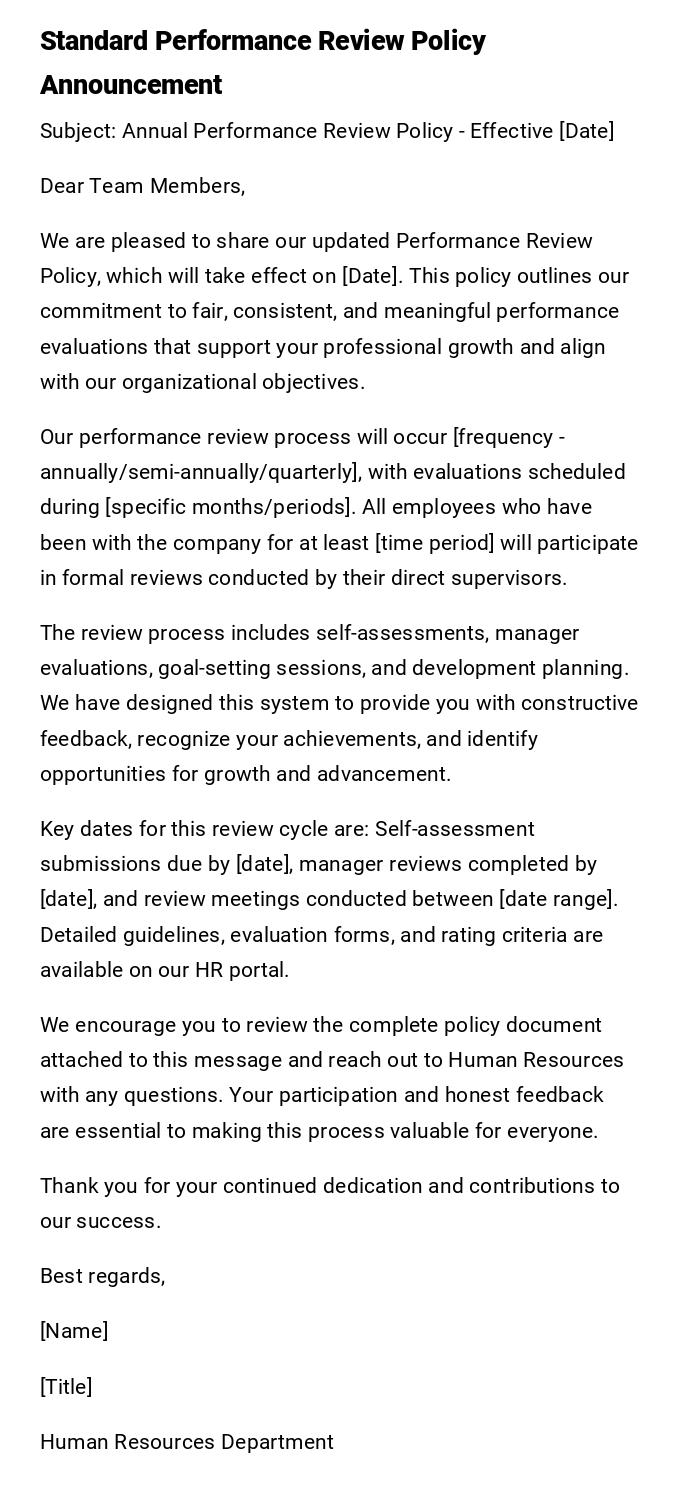
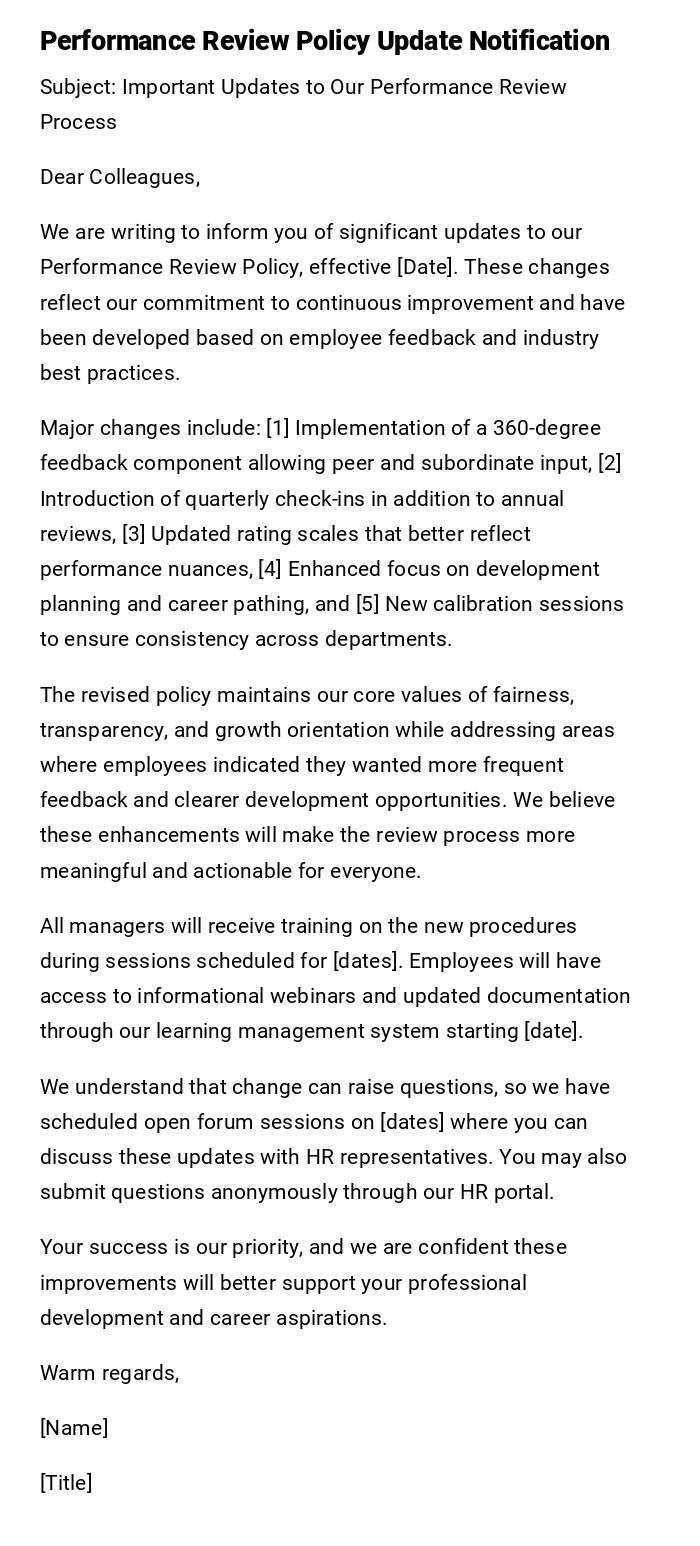
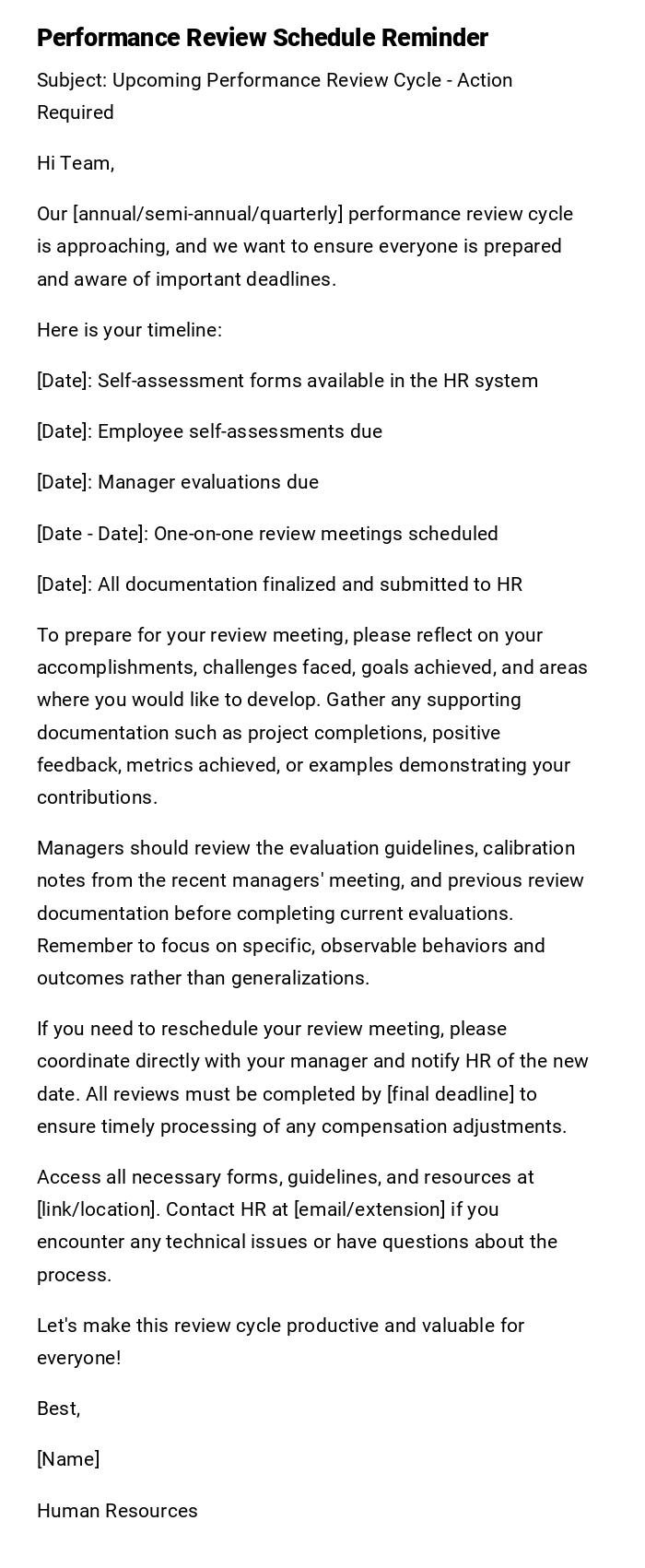
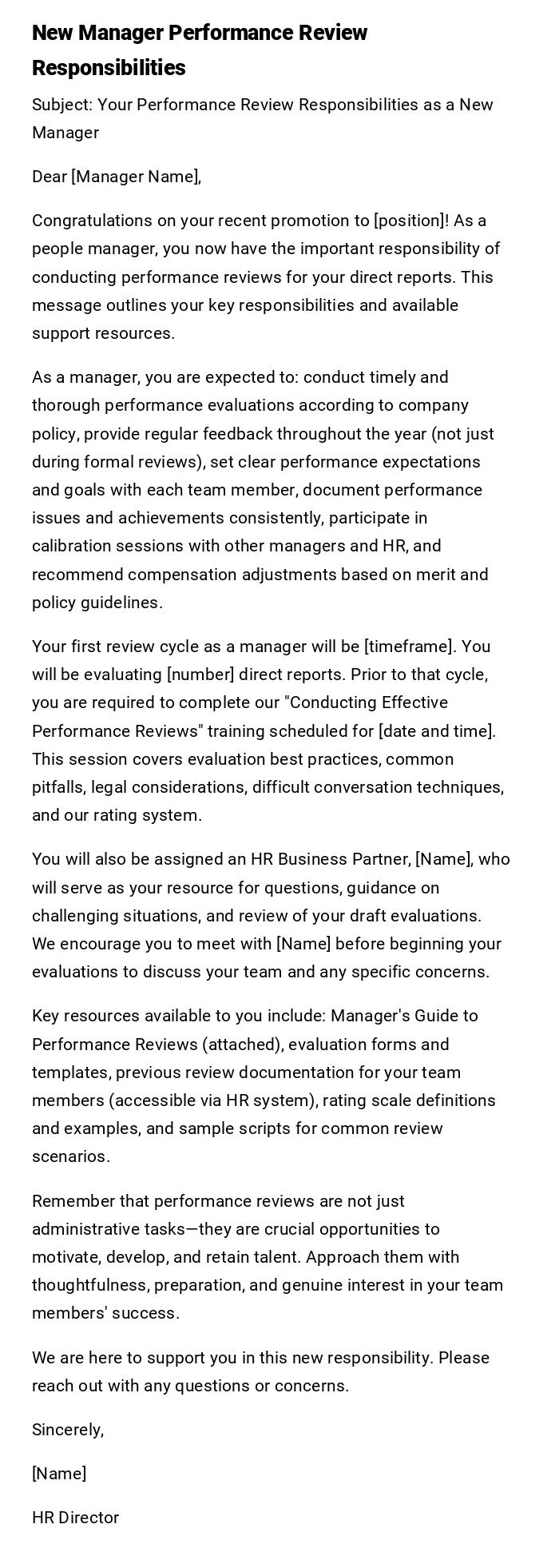
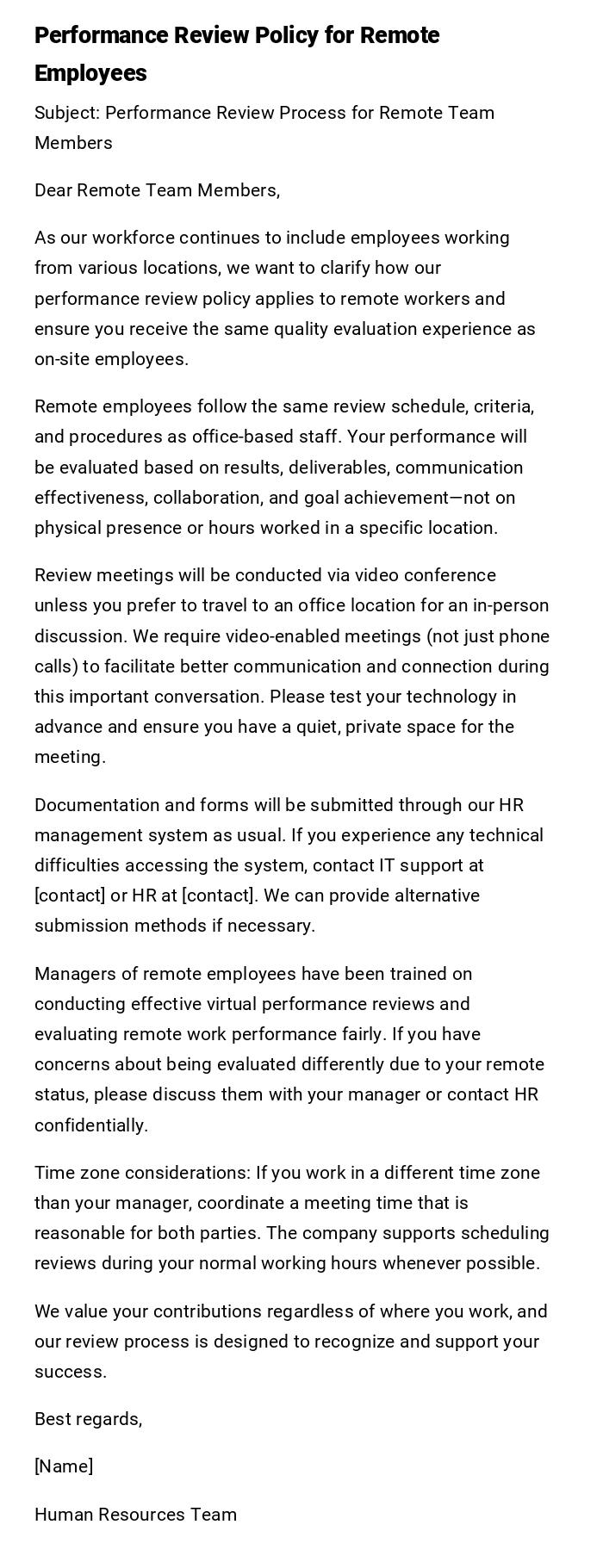
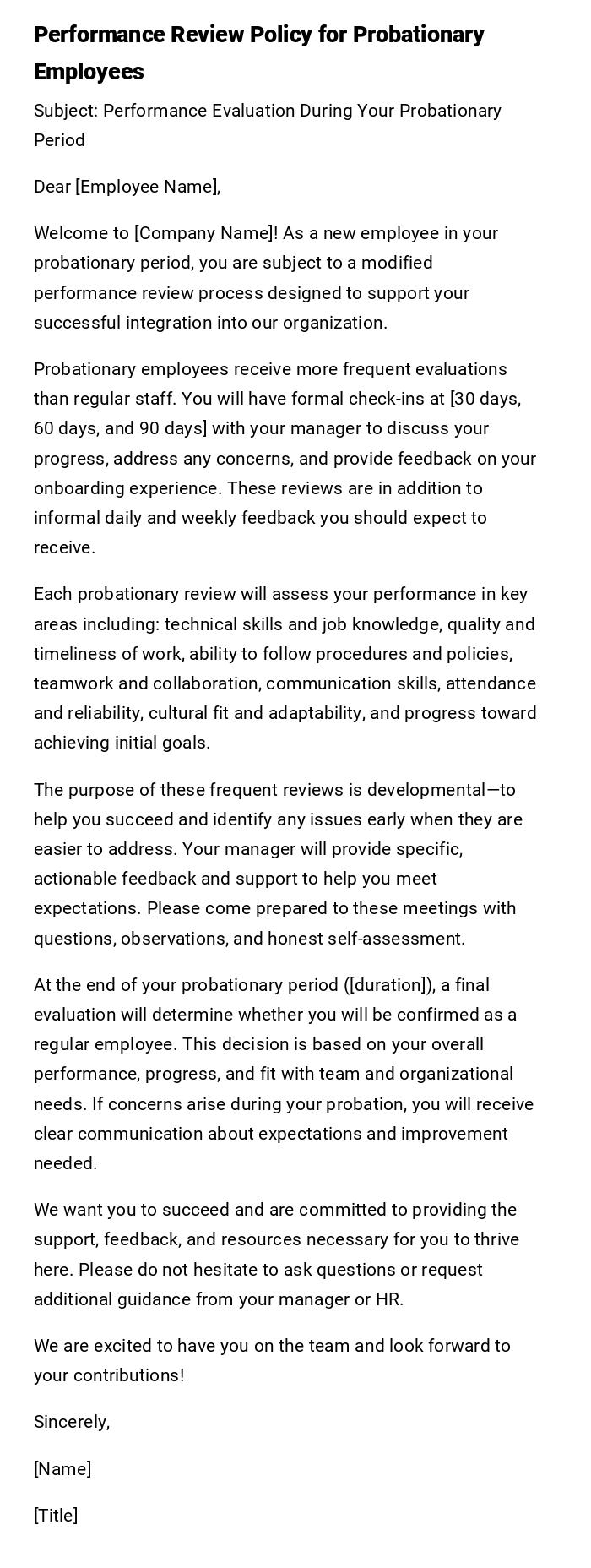
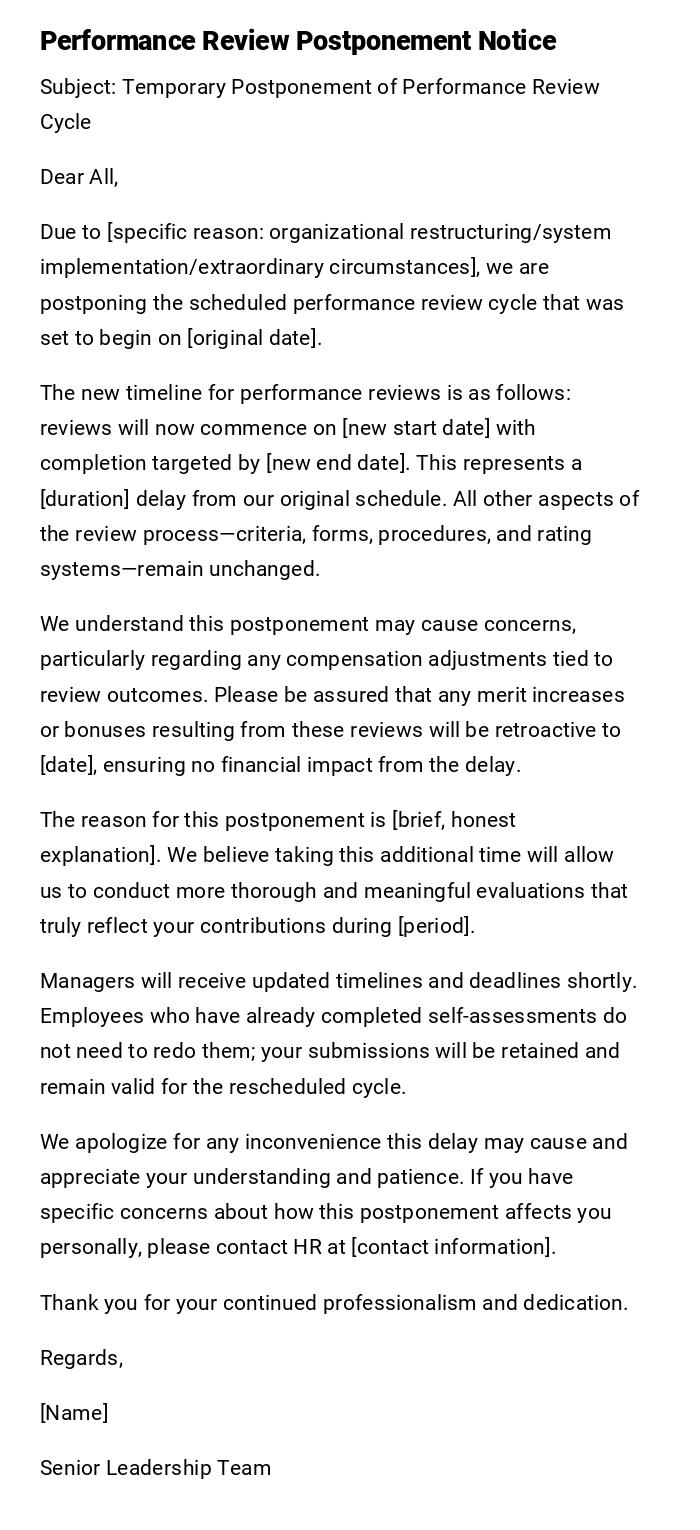

 Download Word Doc
Download Word Doc
 Download PDF
Download PDF